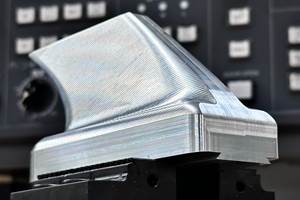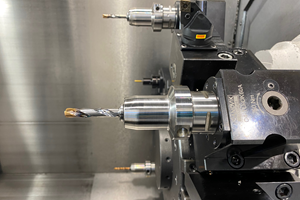Thread Milling On A Tiny Scale
Machining internal threads in difficult materials is challenging, especially when hole diameters are small. Thread milling offers advantages for these applications that are important to consider.
Share





Thread Milling Tiny Threads
Tapping is the preeminent technique shops use to machine internal threads in a variety of materials. That said, thread milling is a viable alternative especially when hole diameters are small and workpiece materials are exotic.
Mark Hemmerling says that although thread milling isn’t new to the machining scene, its use is not widespread. However, the marketing manager for Walter USA points out that thread milling is particularly effective in creating small, internal threads in difficult materials such as titanium and stainless steel because it overcomes the prime challenge in small-scale threading: chip control.
Tapping operations in the materials mentioned above tend to generate stringy chips that can cling to the tap, Mr. Hemmerling explains. This can create a bird’s nest around the tap that can lead to oversized threads or cause the tap to bind and break inside the part. Conversely, thread mills that move in an upward, helical tool path inside a hole generate short, controllable chips that are readily evacuated out of blind or through holes using coolant or an air blast.
The Walter Prototyp division manufactures solid carbide thread mills that can create threads as small as M1.6 with a 3:1 length-to-diameter ratio. The thread milling guidance Mr. Hemmerling offers here is helpful to shops that are looking for a different way to thread tiny holes.
Milling’s Advantages
Thread milling offers the same advantages for threading small holes as it does for standard-sized holes. A single thread milling tool is able to produce both blind and through holes; right- and left-hand threads; and multiple thread sizes that share a common pitch. Thread mills are also able to machine complete threads very close to the bottom of a blind hole because the bottoms of these tools are flat.
In addition to that machining versatility, tool breakage does not necessarily result in workpiece rejection. When taps snap in very hard metals, it might be possible to use EDM hole drilling or some other method to remove the broken tap and salvage the workpiece. In some instances, though, the part is scrapped.
Let’s Go To The Video
A helpful video shows a thread mill creating M2-sized threads in materials ranging from cast iron to titanium. (See the box to the right for the link to that video.) A few aspects of thread milling are clarified in the video, such as the way the small cutter enters the material. The tool moves in an initial downward cutting motion toward the bottom of the hole to begin the cut. This gradual “ramping” into the material allows the tool to achieve full radial engagement and eliminate taper that deflection would cause upon entering the material. After the downward motion, the tool is moved in thread milling’s signature helical tool path up and out of the hole. (Most modern CNC machine tools are capable of performing such helical interpolation.)
The video also shows a side-by-side comparison of tapping and thread milling. You’ll notice that when the tap exits the hole, the machine’s spindle continues to spin the tap as it dwells above the threaded hole. This is part of the rigid tapping cycle that synchronizes the spindle RPM with the feed rate. What’s also evident is the difference in spindle actuation between threading operations. Tapping requires that the spindle start, stop, reverse, stop and start again. On the other hand, thread milling is performed using continuous, single-direction spindle rotation from hole to hole.
Some small thread mills are limited to a threading length-to-diameter ratio of 2:1. However, the TiCN-coated Walter Prototyp thread mills include design elements that reduce deflection and allow threading to depths of 3:1. For instance, a reduced neck and short cutting section of just three pitches minimizes deflection because radial pressure on the tool is reduced. The 15-degree helix strikes a balance between rigidity and chip evacuation, while an oversized shank offers strength and allows for multiple clamping lengths. This proves helpful when machining threads in recessed holes.
Thread milling speeds and feeds must be modified based upon material tensile strength, hardness and elongation characteristics. Walter USA offers an online application called Computer Cutting Data Service (www.cutting-data.com) that assists customers in thread mill selection, recommends speeds and feeds, and estimates tool life. It can also generate thread milling code for many common CNCs.
Related Content
Shop Reclaims 10,000 Square Feet with Inventory Management System
Intech Athens’ inventory management system, which includes vertical lift modules from Kardex Remstar and tool management software from ZOLLER, has saved the company time, space and money.
Read MoreFive Common Mistakes Shops Make with ER Collets (And How to Prevent Them)
Collets play a crucial role in the machining process, so proper tool assembly and maintenance is important. Here are five potential pitfalls to avoid when using ER collets.
Read MoreCustom Workholding Principles to Live By
Workholding solutions can take on infinite forms and all would be correct to some degree. Follow these tips to help optimize custom workholding solutions.
Read MoreForm Tapping Improves Tool Life, Costs
Moving from cut tapping to form tapping for a notable application cut tooling costs at Siemens Energy and increased tool life a hundredfold.
Read MoreRead Next
AMRs Are Moving Into Manufacturing: Considerations for Implementation
AMRs can provide a flexible, easy-to-use automation platform so long as manufacturers choose a suitable task and prepare their facilities.
Read MoreLast Chance! 2025 Top Shops Benchmarking Survey Still Open Through April 30
Don’t miss out! 91ÊÓƵÍøÕ¾ÎÛ's Top Shops Benchmarking Survey is still open — but not for long. This is your last chance to a receive free, customized benchmarking report that includes actionable feedback across several shopfloor and business metrics.
Read MoreMachine Shop MBA
Making Chips and 91ÊÓƵÍøÕ¾ÎÛ are teaming up for a new podcast series called Machine Shop MBA—designed to help manufacturers measure their success against the industry’s best. Through the lens of the Top Shops benchmarking program, the series explores the KPIs that set high-performing shops apart, from machine utilization and first-pass yield to employee engagement and revenue per employee.
Read More






















